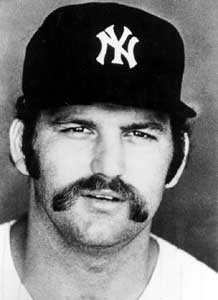
Thurman Munson, 1947–1979 (Image via Wikipedia)
When building the Hall of wWAR, the most exhilarating part of the process was seeing who the most overlooked players were in baseball history. Many of these players became pet cases of mine for the Hall of Fame. I wrote about many of them at length at Beyond the Box Score—19th Century stars Bill Dahlen, Deacon White, and Bob Caruthers, ballot holdovers Jeff Bagwell, Edgar Martinez, Tim Raines, and Alan Trammell, and players with cases that are now left to the Veterans Committee in Kevin Brown, Lou Whitaker, Ted Simmons, Bobby Grich, and Dick Allen. That’s a lot of players to support. And to be honest, there’s actually more.
Today, I want to have a little chat about one of those players—Thurman Munson. Munson hasn’t always been near the top of my list of pet cases. But I’ve… evolved my feelings towards him.
I’ve actually been working on a new Hall of Fame-related project that builds on the Hall of wWAR. Through that project, I’ve identified what I believe should be the Hall of Fame borderline. Thurman Munson sits right on that borderline. Of course, that’s significant for a big reason—Munson never got to finish his career. We lost him at age 32 when a small plane he was piloting crashed in Canton, OH. The fact that he sits on the borderline without the opportunity to finish his career says to me that Thurman Munson was a Hall of Famer.
Here are some more thoughts on Munson before I open it up to you:
- While Munson had certainly started to decline, he had simply fallen from an elite catcher to an above aveage one. He still had a long way to go. In 1978, Munson had accumulated 3.1 WAR. In 1979 (the year he died), Munson had earned 2.2 WAR through 97 games.
- Among Hall of Fame catchers, Carlton Fisk (26.5), Gabby Hartnett (22.0), Ernie Lombardi (14.8), Yogi Berra (11.9), and Bill Dickey (9.0) earned the most WAR from their age 33 season until the end of their careers.
- Let’s look at three non-Hall of Fame peers of Munson’s. Bill Freehan earned just 1.9 WAR from age 33 on. Freehan probably has the most similar career arc to Munson, though Freehan’s career ended quickly for different reasons. Gene Tenace was criminally underrated (and therefore underused) and produced 7.1 WAR in just 833 PAs from 33 on. Ted Simmons is a tricky case. He was worth 0.8 WAR from 33 on, but at age 33 he was worth 3.7 WAR (meaning from 34 on he was worth –2.9 WAR).
- Give Munson another win for the remainder of 1979, a couple more for 1980, and another win or two for partial seasons beyond that (a conservative estimate). His 43.3 WAR could have been closer to 48 (or more) by the time he was done.
- He won an MVP. He was a Rookie of the Year. He was a seven-time All Star (with three starts). He won three Gold Gloves.
- He won two World Series rings. In his three World Series, he hit .373/.417/.493 in 16 games with a homer and 12 RBI. In the LCSs leading to those World Series, he hit .339/.333/.500 with a pair of homers in 14 games.
- His best Hall of Fame voting percentage came in 1981, his first year on the ballot (15.5%). His five years of eligibility were waived. He stayed in the ballot for all fifteen years, receiving 6.5% of the vote in his final try (1995).
Let’s talk about Thurman Munson—his career, his life, his Hall of Fame candidacy… anything.
